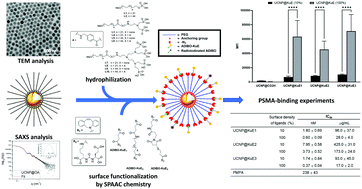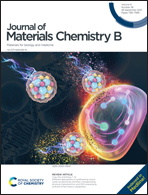Synthesis and in vitro preliminary evaluation of prostate-specific membrane antigen targeted upconversion nanoparticles as a first step towards radio/fluorescence-guided surgery of prostate cancer†
Abstract
Over the last decade, upconversion nanoparticles (UCNP) have been widely investigated in nanomedicine due to their high potential as imaging agents in the near-infrared (NIR) optical window of biological tissues. Here, we successfully develop active targeted UCNP as potential probes for dual NIR–NIR fluorescence and radioactive-guided surgery of prostate-specific membrane antigen (PSMA)(+) prostate cancers. We designed a one-pot thermolysis synthesis method to obtain oleic acid-coated spherical NaYF4:Yb,Tm@NaYF4 core/shell UCNP with narrow particle size distribution (30.0 ± 0.1 nm, as estimated by SAXS analysis) and efficient upconversion luminescence. Polyethylene glycol (PEG) ligands bearing different anchoring groups (phosphate, bis- and tetra-phosphonate-based) were synthesized and used to hydrophilize the UCNP. DLS studies led to the selection of a tetra-phosphonate PEG(2000) ligand affording water-dispersible UCNP with sustained colloidal stability in several aqueous media. PSMA-targeting ligands (i.e., glutamate-urea-lysine derivatives called KuEs) and fluorescent or radiolabelled prosthetic groups were grafted onto the UCNP surface by strain-promoted azide–alkyne cycloaddition (SPAAC). These UCNP, coated with 10 or 100% surface density of KuE ligands, did not induce cytotoxicity over 24 h incubation in LNCaP-Luc or PC3-Luc prostate cancer cell lines or in human fibroblasts for any of the concentrations evaluated. Competitive binding assays and flow cytometry demonstrated the excellent affinity of UCNP@KuE for PSMA-positive LNCaP-Luc cells compared with non-targeted UCNP@CO2H. Furthermore, the binding of UCNP@KuE to prostate tumour cells was positively correlated with the surface density of PSMA-targeting ligands and maintained after 125I-radiolabelling. Finally, a preliminary biodistribution study in LNCaP-Luc-bearing mice demonstrated the radiochemical stability of non-targeted [125I]UCNP paving the way for future in vivo assessments.



 Please wait while we load your content...
Please wait while we load your content...